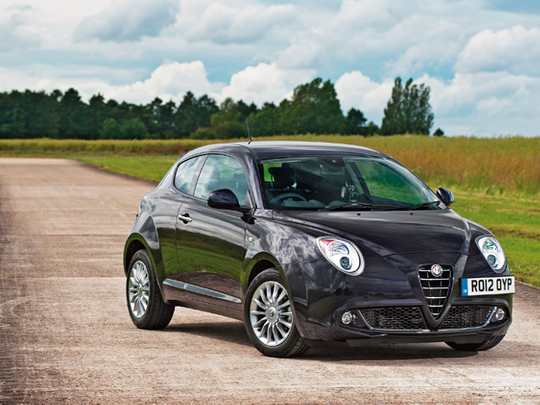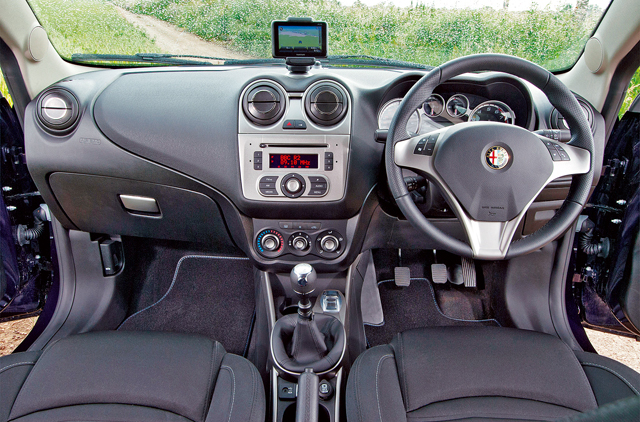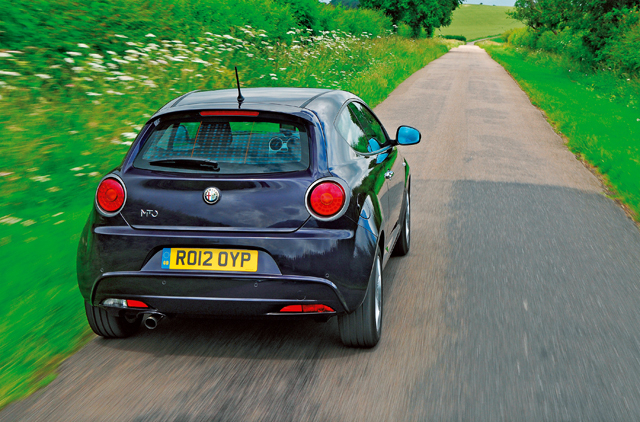
The Mito Twin Air was announced right after Fiat, which owns Alfa Romeo, spilled the beans that more versions of the Twin Air are on the way, with a range of capacities and outputs. At least one won’t even have a turbocharger, in the manner of the original twin-cylinder Fiat 500 of ‘back in the day’, but for now the 84bhp turbocharged 875cc is the only choice among the Fiat Group’s small cars.
Quite why it’s taken so long to migrate to the Mito is a question for another dinner, but it’s there at last — and with tweaks. The same engine is fitted to three or four other models already, the latest being the Fiat Punto. In shifting it across to the Mito, Alfa’s engineers have done something, rumoured to involve a larger diameter exhaust and a change to the impellor blade angle within the furious little turbo. It’s worked wonders, reviving a verve that had started to wane.
By modern standards the Mito isn’t a lightweight car. The entry-level Peugeot 208, for example, is 975kg, while the Mito Twin Air is a comparatively tubby 1,130kg. Expect a round of weight-saving technologies in its next major update, but the way the fettled Twin Air unit handles the mass is light years ahead of other small petrols.
You probably know by now that the Twin Air is force-fed by a small turbo that spins faster than the lead woman in Street Dance, and it gives a kind of zesty performance you just don’t get in normally aspirated small petrol engines. Yes there’s a bit of turbo lag; you can’t get away from it. But the shove as the rev needle spins around the counter to a charismatic thrumming soundtrack is delightful. The engine seems smoother in the Mito than it has done in some of its other foster homes, but arguably even more fun.
Should you be strong of willpower there’s actually a choice of how you want to drive it, courtesy of Alfa’s DNA drive selector switch. Going backwards, A is for All-weather, which basically means normal driving settings but allowing for a bit of wheelspin in slippy conditions, along with tighter control over sideways movement.
N is now for Natural. It used to be ‘Normal’, but apparently that was too… normal. It’s now the default anyway, with moderate traction control settings and reduced power output settings that also apply to All-weather. Use this mode gently for maximum efficiency. D, or Dynamic, functions like an overboost, turning the wick up to 11 (and beyond) and releasing the full banzai torque curve.
Well, that’s how it feels, anyway. In reality, the second of the six gears only just about reaches 65kph, so while you’re giggling away to yourself whacking the gear lever into third, you’re not actually going that quickly at all. It’s all part of the joy.
Another of the happy spin-off factors from the Twin Air system is that even with all the extra turbo and vibration-control gubbins it’s a good 10 per cent lighter than other small petrol engines, so the Mito’s front end has a wonderful crispness of turn-in, darting into corners as if its life depends on it. It always feels so eager to please, and that makes it incredibly likeable.
You can buy a Mito Twin Air in two trim levels; Sprint and Distinctive. Both post 3.49 litres-per-100km economy, but Distinctive cars are the real lookers. With 17in ‘sports’ alloy wheels, red-painted brake callipers, rear parking sensors and a truckload of silver and chrome-effect aesthetic details, it looks as good as the Mito ever has.
Very, then. But even Sprint models get cruise control, Bluetooth, an electronic limited-slip differential, seven airbags, stop-start technology, air conditioning, an alarm and immobiliser, front fog lights and more.
It’s far from spartan, but place the two models side by side and the premium for the Distinctive starts to melt into irrelevance. There are also myriad ways to customise the car, with colour variations on the outside and inside. Alfa limits it to try to avoid any hideous combinations and maintain residual values, but there’s a lot you can do to make it yours.
These days most cars are a bit too anodyne; a bit too sterile. But the Mito Twin Air, thanks to some inspired engine modifications and some styling genius on the higher Distinctive model, is a car with a life — a personality even. I defy anybody to buy one and not end up giving it a name. It has split personalities, with its economical, easy-going side dominating in Natural drive mode, but in Dynamic it gives you fun by the bucket. The fact that you can have both in one great-looking car makes this little Alfa a real gem.
THE MITO TwinAir was announced right after Fiat, which owns Alfa Romeo, spilled the beans that more versions of the TwinAir are on the way, with a range of capacities and outputs. At least one won’t even have a turbocharger, in the manner of the original twin-cylinder Fiat 500 of ‘back in the day’, but for now the 84bhp turbocharged 875cc is the only choice among the Fiat Group’s small cars.
Quite why it’s taken so long to migrate to the Mito is a question for another dinner, but it’s there at last – and with tweaks. The same engine is fitted to three or four other models already, the latest being the Fiat Punto. In shifting it across to the Mito Alfa’s engineers have done something, rumoured to involve a larger diameter exhaust and a change to the impellor blade angle within the furious little turbo. It’s worked wonders, reviving a verve that had started to wane.
By modern standards the Mito isn’t a lightweight car. The entry level Peugeot 208, for example, is 975kg, while the Mito TwinAir is a comparatively tubby 1130kg. Expect a round of weight-saving technologies in its next major update, but the way the fettled TwinAir unit handles the weight is light years ahead of other small petrols.
You probably know by now that the TwinAir is force-fed by a small turbo that spins faster than the lead woman in Street Dance, and it gives a kind of zesty performance you just don’t get in normally-aspirated small petrol engines. Yes there’s a bit of turbo lag; you can’t get away from it. But the shove as the rev needle spins around the counter to a charismatic thrumming soundtrack is delightful. The engine seems smoother in the Mito than it has done in some of its other foster homes, but arguably even more fun.
Should you be strong of willpower there’s actually a choice of how you want to drive it, courtesy of Alfa’s DNA drive selector switch. Going backwards, A is for All-weather, which basically means normal driving settings but allowing for a bit of wheelspin in slippy conditions, along with tighter control over sideways movement.
N is now for Natural. It used to be ‘Normal’, but apparently that was too… normal. It’s now the default anyway, with moderate traction control settings and reduced power output settings that also apply to All-weather. Use this mode gently for maximum efficiency. D, or Dynamic, functions like an overboost, turning the wick up to 11 (and beyond) and releasing the full banzai torque curve.
Well, that’s how it feels, anyway. In reality, the second of the six gears only just about reaches 40mph, so while you’re giggling away to yourself whacking the gear lever into third, you’re not actually going that quickly at all. It’s all part of the joy. Another of the happy spin-off factors from the TwinAir system is that even with all the extra turbo and vibration control gubbins it’s a good 10% lighter than other small petrol engines, so the Mito’s front end has a wonderful crispness of turn-in, darting into corners as if its life depends on it. It always feels so eager to please, and that makes it incredibly likeable.
You can buy a Mito TwinAir in two trim levels; Sprint and Distinctive. Both post the same tax-free 98g/km CO2 output and 67.3mpg fuel economy, but Distinctive cars are the real lookers. With 17-inch ‘sports’ alloy wheels, red-painted brake callipers, rear parking sensors and a truckload of silver and chrome-effect aesthetic details, it looks as good as the Mito ever has. Very, then.
But even Sprint models get cruise control, Bluetooth, an electronic limited-slip differential, seven airbags, stop-start technology, air conditioning, an alarm and immobiliser, front fog lights and more. It’s far from Spartan, but place the two models side by side and the extra £1,200 for the Distinctive starts to melt into irrelevance.
There are also myriad ways to customise the car, with colour variations on the outside and inside. Alfa limits it to try to avoid any hideous combinations and maintain residual values, but there’s a lot you can do to make it yours. These days most cars are a bit too anodyne; a bit too sterile. But the Mito TwinAir, thanks to some inspired engine modifications and some styling genius on the higher Distinctive model, is a car with a life – a personality even.
I defy anybody to buy one and not end up giving it a name. It has split personalities, with its economical, easy-going side dominating in Natural drive mode, but in Dynamic it gives you fun by the bucket. The fact that you can have both in one great-looking car makes this little Alfa a real gem.













